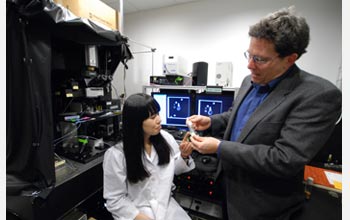All Images
News Release 09-045
Fruit Flies' Response to Wind Offers New Window to Neural Circuits
David J. Anderson and colleagues at Caltech find what lies beneath unlearned behavioral response
This material is available primarily for archival purposes. Telephone numbers or other contact information may be out of date; please see current contact information at media contacts.

Biologist David Anderson and graduate student Suzuko Yorozu examine a vial containing fruit flies. In Anderson's lab researchers were able to cut a hole in the shell that covers the fly's brain for a detailed view. Having used sophisticated techniques to selectively visualize the activity of particular genes in the fly, the researchers could see when any neurons in the fly's brain were activated by a particular stimulus.
Credit: Bob Paz/Caltech
Download the high-resolution JPG version of the image. (2.9 MB)
Use your mouse to right-click (Mac users may need to Ctrl-click) the link above and choose the option that will save the file or target to your computer.
When the wind blows, fruit flies stop. This innate defensive response got biologist David Anderson and his team at Caltech thinking. What neural circuitry underlies this defensive behavior? How is a fruit fly able to use the same organ on its antennae to process the feel of a gentle wind and the sound of a mate, and respond with the appropriate behavior?
Credit: Fly wrangling and camera: Suzuko Yorozu
Sound Editing: David Anderson
Music by Nicolai Rimsky-Korsakov "The Flight of the Bumblebee"
Caltech biologist David Anderson describes his interest in the neural circuits of fruit flies. He is generally interested in defensive behaviors as manifestations of emotional states, and in when and how in evolution emotional states first appeared. The flies' hunkering-down behavior in response to a gentle wind seemed like an interesting model defensive behavior to use to begin to dissect the neural circuits and genes underlying it.
Credit: Caltech and the National Science Foundation
David Anderson tells how his team at Cal Tech identified activated neurons in the brains of fruit flies. Using a two-photon microscope, they were able to peer into the brain of a fruit fly and identify specific neurons "lighting up" in response to wind or the recorded sound of a potential mate's courtship song.
Credit: Caltech and the National Science Foundation
A model system: Caltech biologist David Anderson suggests what can be learned from a fruit fly. Not only are these creatures' brains more complex than imagined even a couple of decades ago, but understanding their neural circuitry has potential future applications in humans. For example, being able to target medications to specific neurons, instead of delivering them to the brain globally, could limit negative side-effects.
Credit: Caltech and the National Science Foundation


